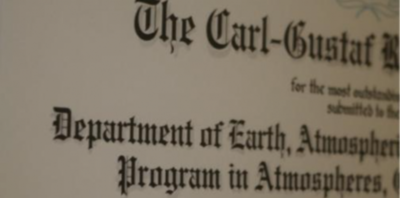PAOC Spotlights
2015 & 2016 Rossby Awards Announced
Jill McDermott '15 and Joern Callies '16 have been awarded the Rossby Prize for their respective theses.

Remembered as one of the major figures in the founding of the modern dynamical study of the atmosphere and ocean, Prof. Carl-Gustaf Rossby’s name is recalled ubiquitously in the fields of Earth and planetary sciences. Rossby waves, the Rossby number, and the Rossby radius of deformation are ideas fundamental to the understanding of all fluid behaviors on a global scale. These insights into the large-scale air movement and mathematical descriptions of atmospheric and oceanic motion are among the reasons that Rossby is credited with the development of modern meteorology.
Further, it was at MIT that Rossby honed much of this work. After being appointed to the faculty in the Department of Aeronautics in 1928, Prof. Carl-Gustaf Rossby founded the study of meteorology and physical oceanography at MIT, and later developed the first Department of Meteorology in an academic institution in the United States. While here, he made significant strides in the understanding of atmospheric heat exchange and turbulence, and relationships between ocean currents and the atmosphere.
In honor of Rossby’s many contributions both to science, and MIT in particular, EAPS' Program in Atmospheres, Oceans and Climate (PAOC) awards the Carl-Gustaf Rossby Award for the best PhD thesis completed in the preceding year within that program. In formulating their decision, the current Rossby Award Committee – comprised of Glenn Flierl, Mick Follows (chair), and Ron Prinn—solicited nominations from the thesis defense chairs of PAOC students graduating in Academic Years 2014-15 and 2015-16.
In recognition of their work, Jill McDermott and Joern Callies were selected as the Rossby Award honorees and will receive a cash award and certificate. Congratulations.
2014-2015 Rossby Award Winner | Jill McDermott

In her doctoral dissertation, MIT-WHOI Joint Program alumna Jill McDermott '15 shared her work to understand the geochemical nature of the sources of reduced carbon at diverse newly discovered hydrothermal vents. This is an important question since abiotically produced hydrogen and hydrocarbons provide energy for chemoautotrophic life in the deep sea with particular significance for understanding the origins of life on Earth.
To do this, Jill joined a multi-disciplinary team, hunting for hydrothermal vents along the Mid-Cayman Rise (MCR), which is an ultraslow spreading center and the deepest known mid-ocean ridge on Earth. After finding two vents, McDermott went to sea, measuring dissolved methane to trace the plume signals to their source, where she sampled vent fluids.
Over the next 3 years, Jill performed a comprehensive array of chemical and isotopic analysis on inorganic and organic compound samples from multiple vents. She analyzed these with thermodynamic and mixing models to infer that the significant source of methane at the vents is derived from fluid inclusions in the host rocks, while other reduced carbon compounds are formed in the hydrogen rich vent fluids at the springs. In ocean floor fissures like these vents, “the fluids undergo reactions with rock at high temperatures and pressures, become buoyant and rise to the seafloor, where they play a role in modulating global seawater chemistry and supporting chemosynthetic ecosystems at the seafloor and in the chemical-rich plume.” She also measured multiple sulfur isotopes in metallic and hydrogen sulfides and sulfur, and used them to constrain sulfur sources and past hydrothermal activity. Her pioneering thesis work was published in two impactful first-authored papers.
“My thesis generated several new ideas under investigation, such as understanding the abundance and distribution of hydrocarbons in seafloor rocks, and experimentally testing hypotheses about H2 generation and organic abiotic synthesis reactions at high temperatures and pressures,” she said.
McDermott is now an assistant professor in the Earth and Environmental Sciences department at Lehigh University where she continues to investigate the aqueous and volatile geochemistry and biogeochemistry of seafloor hydrothermal vents and ancient terrestrial fracture waters tapped by deep mines. These systems link fundamental geologic and biological processes that sustain microbial life in the largely unexplored deep subsurface biosphere, and they represent modern analogues of environments that may have played a critical role in the origin of life on the early Earth.
During her time with MIT and WHOI, McDermott received support and feedback from her advisors Jeffrey S. Seewald, and Christopher R. German (WHOI), who left a lasting impression on her and her work. “I am grateful for the scientific creativity and cheerful outlook of my advisors and committee members, who continually encourage my research and career endeavors,” McDermott said. “I found my thesis work to be simultaneously challenging, motivating and energizing, and I am grateful for the talented group of researchers, technical staff, administrators, and fellow students with whom I worked at MIT and WHOI.”
McDermott, J. (2015), Geochemistry of deep-sea hydrothermal vent fluids from the Mid-Cayman Rise, Caribbean Sea, DSPACE, MIT
2015-2016 Rossby Award Winner | Joern Callies
 In his doctoral dissertation, Joern Callies '16 reported his work to understand the nature and dynamics of sub-mesoscale motions in the ocean—turbulence that occurs in the top hundred meters. Occurring on scales that are difficult to observe systematically, features at this scale are implicated in the transfer of material—particularly carbon—and heat between the atmosphere and surface waters and interior of the ocean. “We were trying to understand what energizes these sub-mesoscale flows and there was a paradigm that they were driven by mesoscale frontogenesis,” Callies said.These consist of ocean eddies about a thousand meters deep that pinch together at the surface and form temperature fronts. “But when I started looking at observations for evidence of this process, we didn’t really find the characteristics that were predicted.” Yet, to date, a clear theoretical and mechanistic understanding has been elusive.
In his doctoral dissertation, Joern Callies '16 reported his work to understand the nature and dynamics of sub-mesoscale motions in the ocean—turbulence that occurs in the top hundred meters. Occurring on scales that are difficult to observe systematically, features at this scale are implicated in the transfer of material—particularly carbon—and heat between the atmosphere and surface waters and interior of the ocean. “We were trying to understand what energizes these sub-mesoscale flows and there was a paradigm that they were driven by mesoscale frontogenesis,” Callies said.These consist of ocean eddies about a thousand meters deep that pinch together at the surface and form temperature fronts. “But when I started looking at observations for evidence of this process, we didn’t really find the characteristics that were predicted.” Yet, to date, a clear theoretical and mechanistic understanding has been elusive.
Using theory, simulations and elegant analysis of observed data, Joern identified regional variations in the nature of submesoscale features. “Instead we found that this turbulence is more energetic in winter than it is in summer, and that it’s more energetic in the surface layer that’s well-mixed in the winter, than it is below,” Callies said. His findings suggested that there were different mechanisms at play during different seasons, and in his thesis, he highlighted the role of baroclinic instability and seasonal variations in the mixed-layer as key controls. These are instabilities that laterally slide warm water over cold, creating horizontal motion and can be characterized at the sub-mesoscale range. “That [movement] has implications for how the flow evolves and how it exchanges properties vertically. Then I followed that up, trying to understand turbulence driven by this mechanism.”
In a series of chapters, his thesis builds to provide a new and comprehensive view of these features. Prof. Raffaele Ferrari advised Callies during the preparation of his thesis, and several chapters have been published and are already well cited.
Callies remains in EAPS as a postdoc pending a move west in Fall 2017 when he will take up a position as an assistant professor at Caltech. Callies’ current research aims at improving our understanding of the ocean circulation and its role in climate. With a continuing interest in the dynamics and impacts of sub-mesoscale turbulence in the upper ocean, Callies is focusing on fronts and currents 1–10 km in horizontal extent, which are thought to achieve important exchanges of heat, carbon, and other tracers between the surface and interior ocean. He is also greatly interested in the large-scale circulation of the abyssal ocean, which connects the vast deep-ocean reservoirs of heat and carbon with the atmosphere and thus plays a crucial role in setting the pace of past and future climate change.
Callies, J. (2016), Submesoscale turbulence in the upper ocean, DSPACE, MIT